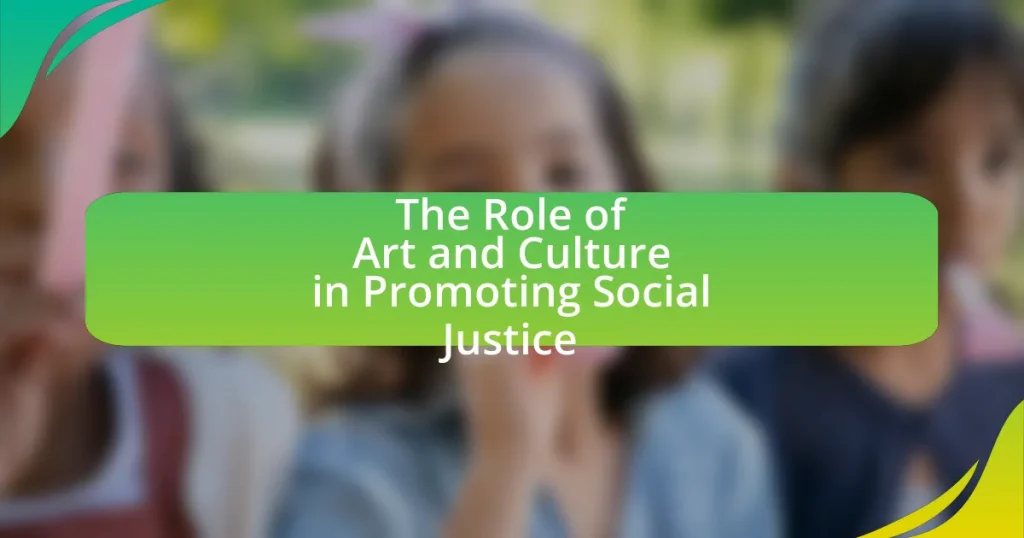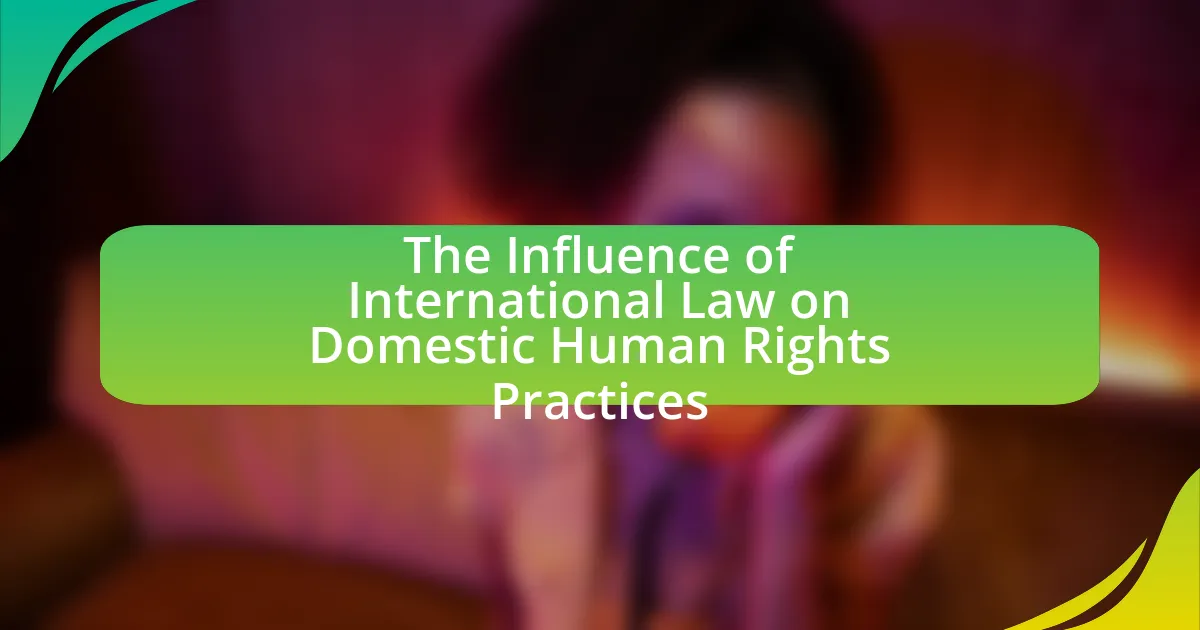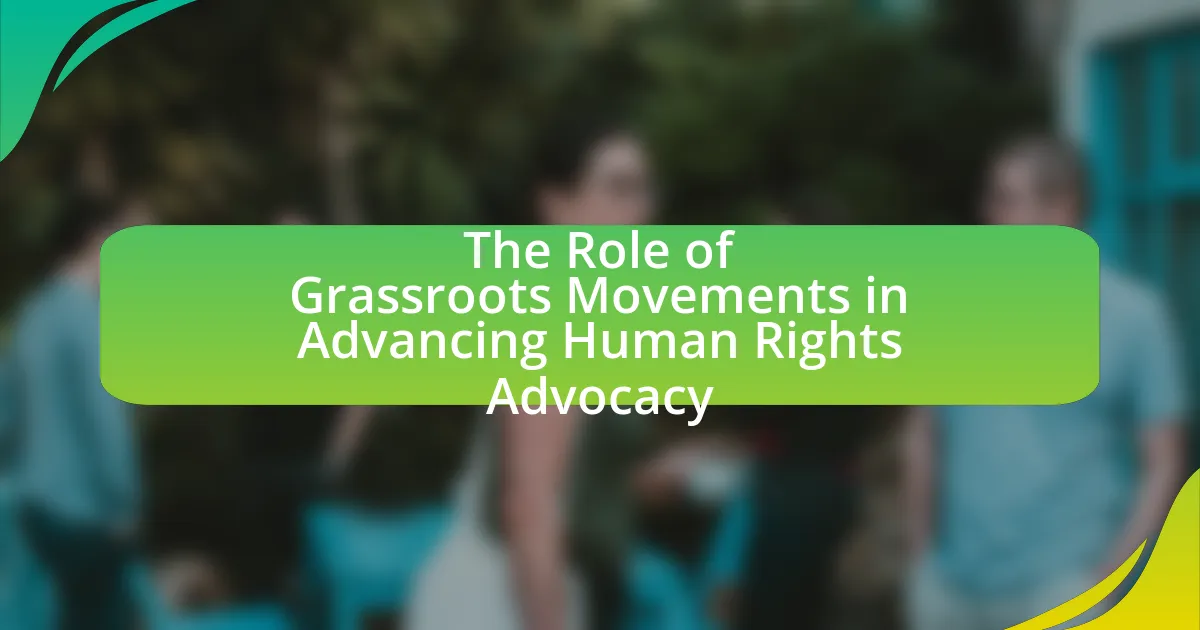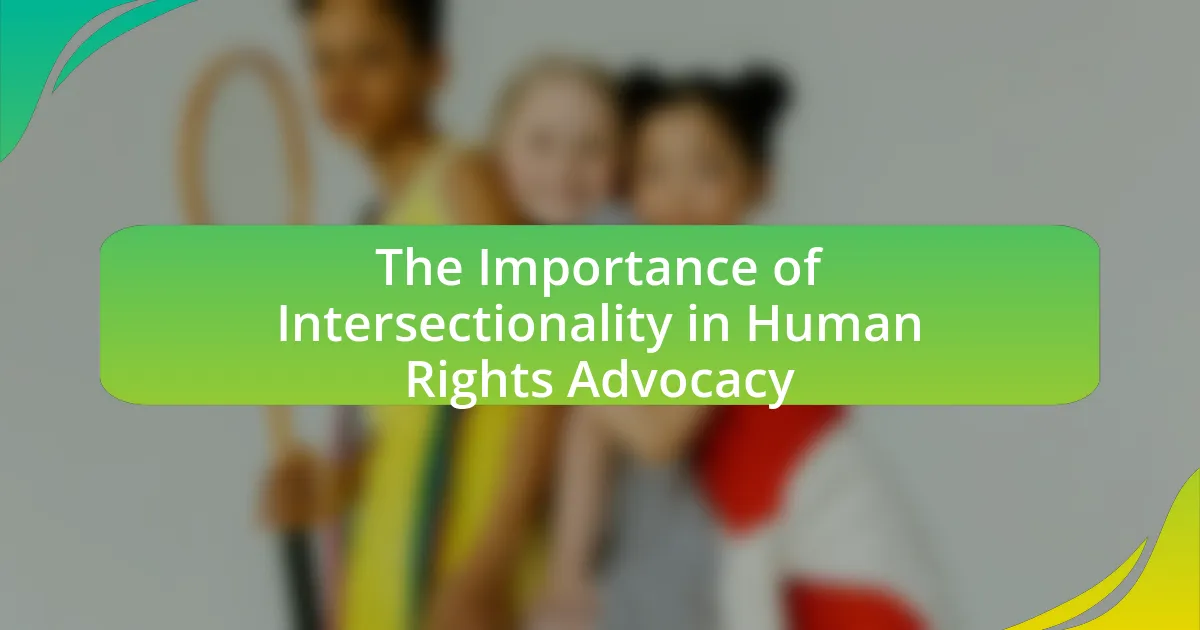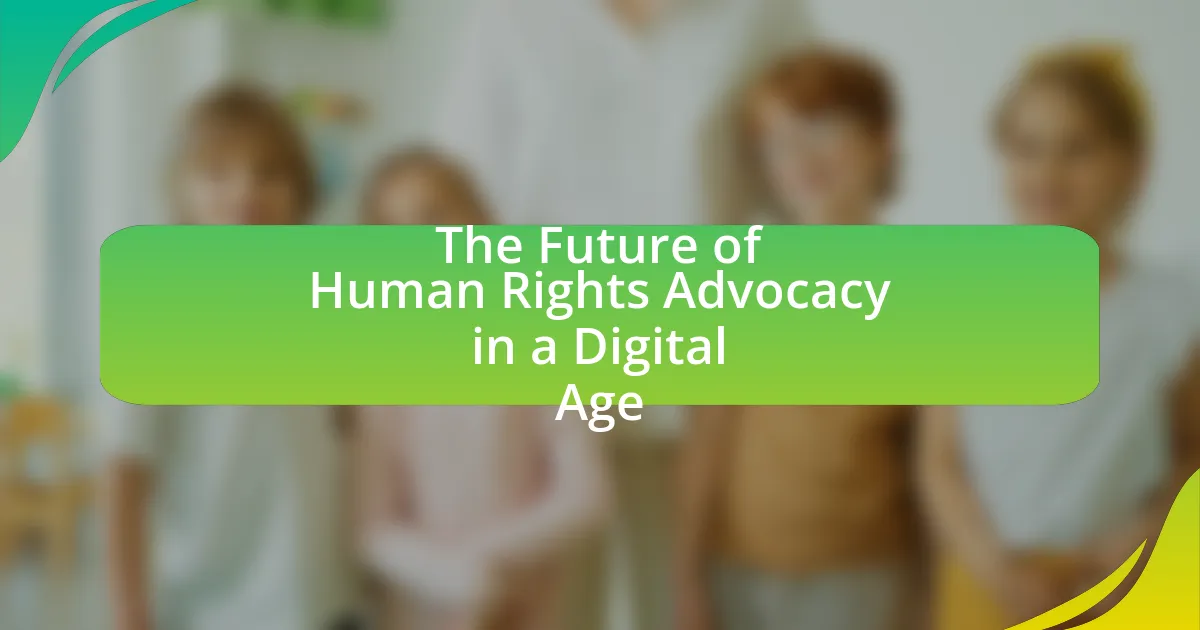The article examines the significant role of art and culture in promoting social justice by providing a platform for marginalized voices and fostering empathy within communities. It explores how various artistic forms, including visual arts, music, and literature, have historically intersected with social justice movements, exemplified by the Civil Rights Movement and contemporary initiatives like Black Lives Matter. The discussion highlights the psychological effects of art on social awareness, the challenges artists face in addressing controversial topics, and best practices for leveraging art to advocate for social change. Additionally, it emphasizes the importance of community engagement and education in enhancing the impact of artistic expression on social justice efforts.
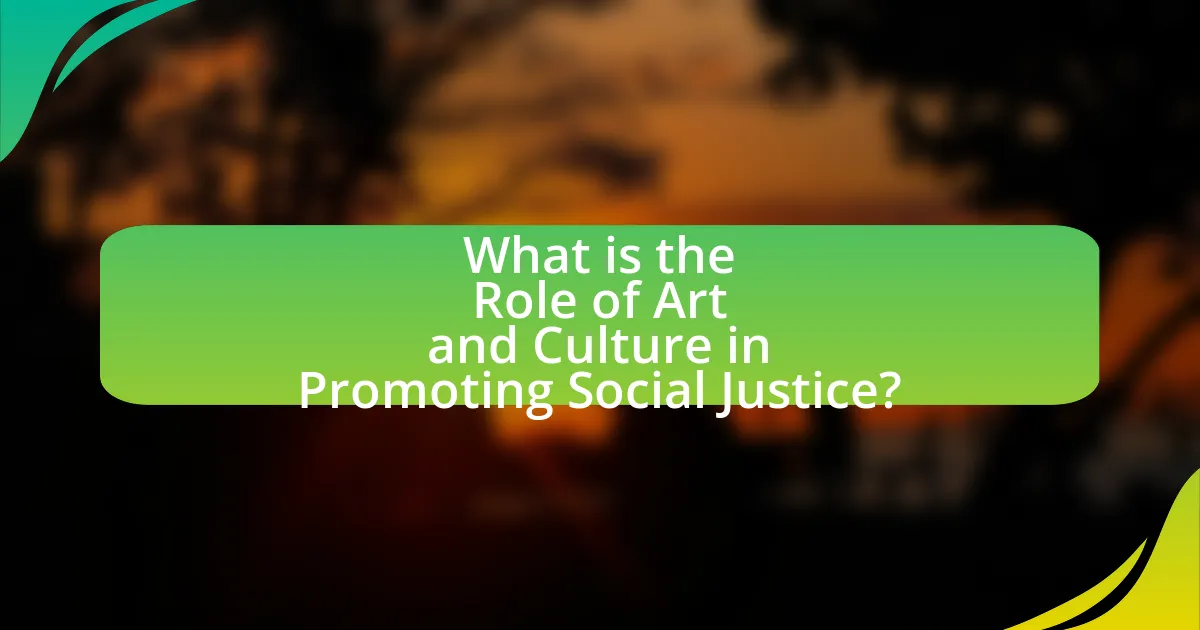
What is the Role of Art and Culture in Promoting Social Justice?
Art and culture play a crucial role in promoting social justice by providing a platform for marginalized voices and fostering empathy among diverse communities. Through various forms of expression, such as visual arts, music, and literature, artists can highlight social issues, challenge injustices, and inspire collective action. For instance, the Civil Rights Movement in the United States utilized music and visual art to communicate messages of equality and resistance, significantly influencing public opinion and policy changes. Additionally, studies have shown that community-based art initiatives can enhance social cohesion and empower individuals, leading to increased civic engagement and advocacy for social change.
How do art and culture intersect with social justice movements?
Art and culture intersect with social justice movements by serving as powerful tools for expression, awareness, and mobilization. Artistic mediums such as visual art, music, and literature often reflect societal issues, challenge injustices, and inspire collective action. For instance, the Civil Rights Movement in the United States utilized music, such as the songs of Nina Simone and Sam Cooke, to convey messages of resistance and hope, galvanizing public support and participation. Additionally, contemporary movements like Black Lives Matter leverage social media platforms to disseminate art that highlights racial inequality, fostering community engagement and dialogue. This intersection demonstrates that art and culture not only document social struggles but also actively shape and influence the trajectory of social justice initiatives.
What historical examples illustrate this intersection?
Historical examples illustrating the intersection of art, culture, and social justice include the Harlem Renaissance and the Civil Rights Movement. During the Harlem Renaissance in the 1920s, African American artists and writers, such as Langston Hughes and Zora Neale Hurston, used their work to challenge racial stereotypes and advocate for civil rights, significantly influencing American culture. Similarly, during the Civil Rights Movement of the 1950s and 1960s, artists like Nina Simone and the visual works of Charles White highlighted racial injustices and inspired activism through powerful music and art, contributing to the broader fight for equality. These movements demonstrate how art and culture can serve as catalysts for social change and justice.
How do contemporary artists address social justice themes?
Contemporary artists address social justice themes by creating works that reflect societal issues such as inequality, discrimination, and human rights violations. For instance, artists like Ai Weiwei use installations and public art to raise awareness about refugee crises and government oppression, effectively engaging audiences in critical conversations. Additionally, the work of artists like Kara Walker employs historical narratives to confront racial stereotypes and injustices, prompting viewers to reflect on America’s complex history with race. These artistic expressions not only highlight social issues but also inspire activism and community engagement, demonstrating the powerful role of art in advocating for social change.
Why is art considered a powerful tool for social change?
Art is considered a powerful tool for social change because it effectively communicates complex social issues and evokes emotional responses that can inspire action. Through various forms such as visual art, music, and performance, artists can challenge societal norms, raise awareness about injustices, and mobilize communities. Historical examples include the civil rights movement, where songs like “We Shall Overcome” galvanized support for racial equality, and the use of street art to highlight issues like police brutality, as seen in the works of artists like Banksy. These instances demonstrate how art can transcend language barriers and reach diverse audiences, making it a vital medium for advocacy and transformation in society.
What psychological effects does art have on social awareness?
Art significantly enhances social awareness by fostering empathy and encouraging critical reflection on societal issues. Through various forms of expression, such as visual arts, music, and literature, individuals are exposed to diverse perspectives and experiences, which can challenge preconceived notions and stimulate emotional responses. Research indicates that engaging with art can lead to increased understanding of social injustices, as evidenced by studies showing that participants who viewed art addressing social issues reported heightened awareness and concern for those issues. For instance, a study published in the journal “Psychology of Aesthetics, Creativity, and the Arts” found that exposure to socially relevant art increased participants’ willingness to engage in social activism. Thus, art serves as a powerful tool for psychological engagement, promoting social awareness and inspiring action towards social justice.
How can art mobilize communities for social justice?
Art can mobilize communities for social justice by serving as a powerful tool for expression, awareness, and collective action. Through various forms such as visual art, performance, and music, artists can highlight social issues, provoke dialogue, and inspire community engagement. For example, the “Art for Social Change” movement has demonstrated how murals and public installations can raise awareness about systemic inequalities, fostering a sense of solidarity among community members. Additionally, studies have shown that participatory art projects, like those documented in “The Role of Art in Social Movements” by the University of California, can enhance community cohesion and empower marginalized voices, ultimately driving social change.
What are the different forms of art that promote social justice?
Different forms of art that promote social justice include visual arts, performance arts, literature, music, and digital media. Visual arts, such as murals and installations, often address social issues and inspire community engagement, exemplified by the works of artists like Banksy, who critiques societal norms. Performance arts, including theater and dance, can convey powerful messages about inequality and human rights, as seen in productions like “The Vagina Monologues,” which raises awareness about gender-based violence. Literature, through novels and poetry, provides narratives that highlight social injustices, with authors like Toni Morrison exploring themes of race and identity. Music serves as a tool for activism, with genres like hip-hop and folk music addressing social issues; for instance, artists like Kendrick Lamar use their platform to discuss systemic racism. Digital media, including social media campaigns and online art projects, mobilizes communities and spreads awareness rapidly, as demonstrated by the #BlackLivesMatter movement, which utilizes art to advocate for racial justice. Each of these forms of art plays a crucial role in fostering dialogue and inspiring action towards social change.
How does visual art contribute to social justice narratives?
Visual art contributes to social justice narratives by providing a powerful medium for expression and raising awareness about social issues. Through visual storytelling, artists can depict injustices, challenge societal norms, and inspire dialogue among diverse audiences. For instance, the works of artists like Ai Weiwei and Kara Walker address themes of oppression and identity, effectively engaging viewers in critical conversations about human rights and systemic inequality. Studies have shown that visual art can evoke emotional responses, making complex social issues more relatable and prompting action. This capacity to connect emotionally with audiences enhances the impact of social justice narratives, making visual art an essential tool in advocacy and activism.
What role does performance art play in raising awareness?
Performance art plays a crucial role in raising awareness by engaging audiences emotionally and intellectually on social issues. This form of art often addresses topics such as inequality, discrimination, and human rights, prompting viewers to reflect on these critical matters. For instance, the performance piece “The Artist is Present” by Marina Abramović highlighted themes of presence and vulnerability, drawing attention to the human experience and societal issues. Research indicates that performance art can evoke empathy and provoke dialogue, making it an effective medium for social change. Studies show that audiences who engage with performance art are more likely to discuss and act on the issues presented, thereby amplifying awareness and fostering community engagement.
How can culture influence perceptions of social justice?
Culture significantly influences perceptions of social justice by shaping values, beliefs, and norms within a society. For instance, cultural narratives and historical contexts can determine what is considered just or unjust, as seen in various movements where art and literature reflect societal struggles and aspirations for equity. Research indicates that communities with strong cultural identities often mobilize more effectively for social justice causes, as evidenced by the Civil Rights Movement in the United States, where music and art played pivotal roles in conveying messages of equality and resistance. Thus, culture acts as both a lens and a catalyst for understanding and advocating for social justice.
What cultural narratives shape our understanding of justice?
Cultural narratives that shape our understanding of justice include historical accounts, folklore, religious teachings, and contemporary media representations. These narratives influence societal perceptions of fairness, accountability, and moral responsibility. For instance, the narrative of the civil rights movement in the United States, as depicted in literature and film, emphasizes themes of equality and resistance against oppression, shaping public discourse on justice. Additionally, religious texts, such as the Bible and the Quran, provide moral frameworks that inform concepts of justice within various cultures. Studies, such as those by sociologist Howard Becker, highlight how cultural narratives can legitimize or challenge existing legal systems, demonstrating their profound impact on societal views of justice.
How do cultural events foster dialogue on social issues?
Cultural events foster dialogue on social issues by providing a platform for diverse voices and perspectives to be shared and discussed. These events, such as art exhibitions, theater performances, and music festivals, often address themes related to social justice, inequality, and community challenges, encouraging attendees to engage in conversations that might not occur in traditional settings. For instance, the “Ferguson: An American Tradition” exhibition highlighted racial tensions and sparked discussions on police brutality and systemic racism, demonstrating how art can serve as a catalyst for social discourse. By creating an inclusive environment where individuals can express their experiences and viewpoints, cultural events promote understanding and empathy, ultimately contributing to social change.
What challenges do artists face in promoting social justice?
Artists face significant challenges in promoting social justice, primarily due to censorship, funding limitations, and societal backlash. Censorship can restrict artistic expression, as governments or institutions may suppress works that challenge the status quo or provoke controversy. Funding limitations often hinder artists’ ability to create and disseminate their work, as many rely on grants or sponsorships that may not support politically charged themes. Additionally, societal backlash can manifest in public criticism or even threats, discouraging artists from addressing sensitive issues. These challenges are evident in various instances, such as the 2017 removal of a mural in Philadelphia that depicted social justice themes, illustrating the risks artists encounter when confronting societal norms.
How do censorship and funding affect artistic expression?
Censorship and funding significantly restrict artistic expression by limiting the themes and messages that artists can explore. Censorship can manifest through government regulations, societal pressures, or institutional policies that suppress controversial or dissenting viewpoints, thereby stifling creativity and critical discourse. For instance, in countries with strict censorship laws, artists often face legal repercussions for works that challenge political or cultural norms, leading to self-censorship and a homogenization of artistic output.
Funding also plays a crucial role; artists reliant on grants or sponsorships may alter their work to align with the interests of funders, which can dilute their original vision. Research by the National Endowment for the Arts indicates that financial support often comes with expectations that can limit the scope of artistic exploration. Consequently, both censorship and funding create an environment where artistic expression is often compromised, ultimately affecting the role of art in promoting social justice and challenging societal issues.
What risks do artists take when addressing controversial topics?
Artists face significant risks when addressing controversial topics, including backlash from audiences, censorship, and potential harm to their careers. Backlash can manifest as public criticism, loss of support from patrons, or negative media coverage, which can damage an artist’s reputation and financial stability. Censorship may occur when institutions or governments restrict access to their work, limiting the artist’s ability to express their views. Additionally, artists may experience personal threats or violence, particularly in politically charged environments, as seen in cases where artists have faced legal repercussions or physical harm for their expressions. These risks highlight the precarious position artists occupy when engaging with sensitive social issues, underscoring the courage required to promote social justice through their work.
How can communities leverage art and culture for social justice?
Communities can leverage art and culture for social justice by using creative expressions to raise awareness, foster dialogue, and mobilize action around social issues. For instance, public murals and performances can highlight systemic inequalities, while community theater can provide a platform for marginalized voices, encouraging discussions that lead to social change. Research shows that art initiatives, such as the “Art for Justice Fund,” have successfully funded projects that address mass incarceration and racial inequality, demonstrating the tangible impact of art in advocating for social justice.
What strategies can be employed to engage local artists?
To engage local artists, community organizations can implement collaborative projects that foster participation and creativity. These projects can include art festivals, workshops, and public art installations that invite local artists to showcase their work and connect with the community. Research indicates that community engagement in the arts enhances social cohesion and promotes cultural expression, as seen in initiatives like the National Endowment for the Arts’ “Our Town” program, which supports creative placemaking. By providing platforms for local artists to collaborate and share their perspectives, communities can strengthen their cultural fabric and promote social justice through artistic expression.
How can collaborative art projects enhance community solidarity?
Collaborative art projects enhance community solidarity by fostering connections among individuals through shared creative experiences. These projects encourage participation from diverse community members, allowing them to express their identities and perspectives collectively. Research indicates that such engagement can lead to increased social cohesion, as seen in initiatives like the “Community Art Project” in San Francisco, which brought together residents from various backgrounds to create murals that reflect their shared history and aspirations. This collective effort not only beautified the neighborhood but also strengthened relationships among participants, demonstrating that art can serve as a powerful tool for building unity and understanding within communities.
What are best practices for using art and culture to advocate for social justice?
Best practices for using art and culture to advocate for social justice include fostering community engagement, utilizing diverse artistic mediums, and amplifying marginalized voices. Community engagement ensures that the art reflects the experiences and needs of those it aims to represent, creating a sense of ownership and relevance. Diverse artistic mediums, such as visual arts, music, theater, and literature, can reach broader audiences and evoke emotional responses that inspire action. Amplifying marginalized voices is crucial, as it allows those directly affected by social injustices to share their stories, fostering empathy and understanding among wider audiences. Research by the National Endowment for the Arts indicates that community-based art initiatives can significantly enhance civic engagement and social cohesion, demonstrating the effectiveness of these practices in promoting social justice.
How can organizations effectively support artists in their advocacy efforts?
Organizations can effectively support artists in their advocacy efforts by providing funding, resources, and platforms for visibility. Financial support enables artists to focus on their work without the burden of economic constraints, as evidenced by the National Endowment for the Arts, which awarded over $27 million in grants to support artistic projects in 2020. Additionally, organizations can offer workshops and training that enhance artists’ skills in advocacy and communication, fostering a more impactful message. Creating partnerships with community organizations amplifies artists’ voices, as seen in initiatives like Art for Justice, which collaborates with artists to address social issues. By facilitating access to networks and audiences, organizations empower artists to engage effectively in social justice advocacy.
What role does education play in fostering a culture of social justice through art?
Education plays a crucial role in fostering a culture of social justice through art by equipping individuals with the critical thinking skills necessary to analyze societal issues and express their perspectives creatively. Through art education, students learn to engage with themes of inequality, identity, and activism, which empowers them to challenge injustices and advocate for change. For instance, programs that integrate social justice themes into art curricula have been shown to enhance students’ awareness of social issues and encourage community engagement, as evidenced by initiatives like the “Art for Social Change” movement, which promotes artistic expression as a means of addressing social disparities.
